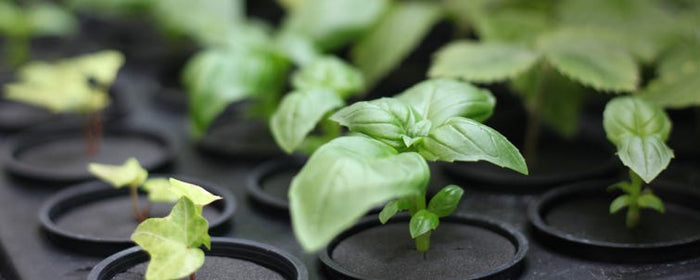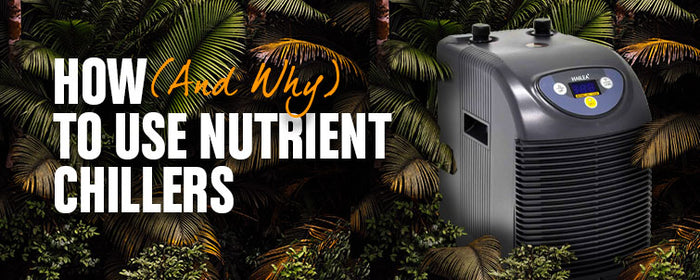![[Q&A] Adjust-A-Wings! How to Raise your Game](http://www.growell.co.uk/cdn/shop/articles/blog__q_a_adjust-a-wings_howtoraiseyourgame.jpg?v=1673520423&width=1100)
[Q&A] Adjust-A-Wings! How to Raise your Game
Anyone can tell you Adjust-A-Wings are good! But how and why did they happen? Founder and creator Paul's here to tell the story behind his award-winning reflectors.

Q
What inspired the design of the classic Adjust-A-Wings reflector?
A
It was based on a then famous reflector called “The Max 89”.
Back in the day, Max 89s were advertised in the popular USA grow magazines and were reported to outperform all other well known reflectors by as much as 89%. Their success was attributed to a unique and precisely constructed double parabolic shape.
I was never going to get my hands on a Max 89 (being a kid from Australia) – so I decided to make my own.
Q
You make it sound so simple! How did you do it?

A
I traced over a photograph to get a crude pattern, removed the skin from an old washing machine to get the sheet metal, which was already reflective and powder coated in polar white.
I then got to work with tin snips, tie wire and some nuts, bolts and screws.
By the end of the day, I’d fashioned a “Frankenstein 89” reflector that looked the part and even had a couple of added features (adjustable wing width and adjustable lamp height).
The exact wing width and the lamp height were difficult to determine from the tiny picture I’d traced around. So I decided to let them stay moveable and experiment a bit to determine their final positions.
Q
Sounds logical. How long before you realized you were on to something?
A
Not very long! The new double parabolic reflector outperformed anything I’d used before. The first crop was an eye opener and a personal best at that point.
In the end I grew about 20 crops with that reflector. Each new crop outdid the last. I grew with wide wing settings, narrow wing settings, high lamp positions, low lamp positions …. I quickly learned that there was no magic Max 89 combination. However, there was definitely magic in the combinations themselves!
Q
Interesting. Tell us more about the wing settings.
A
Gladly. Narrow settings with deep wing curves created concentrated light footprints. When narrow set reflectors were placed at considerable distances from plants, they produced spring-like conditions with broad, even footprints. Powerful in light delivery but low on heat.
Wide settings with shallow wing curves also created broad, even light footprints. However, these suited closer placement to plants and simulated summer conditions. You’d get a powerful, warm dispersion of light with the unique ability to penetrate deep within plant canopies. The multi-angular light emissions would weave their way between leaves and around branches to stimulate rapid flower production throughout the entire plant (not just the tops).
And the Intermediate settings, with mid-depth wing curves, were perfect for placing at moderate distances from plants. They created autumn-like conditions, which promoted uniform and complete flower maturation whilst maintaining vitality across the most temperamental and essential stage in a plants growth.
On the back of those discoveries (and others) I registered my first horticultural lighting related patent and began the business that has been running continually and keeping me busy to this day.
Q
You spoke a bit about mimicking the seasons there – can you tell us more about that?
A
Of course. All plants have evolved to rely on seasonal climate changes to guide them through their life cycles.
Indoor gardeners who rely on artificial light commonly grow plants classed as ‘fast growing light loving annuals.’ Such plants often rely heavily on seasonal changes/triggers.
Accordingly, variations in light intensity and temperature are ‘expected’ by plants and necessary to trigger the hormonal changes which govern vitality and progress through the course of their lives.
Any indoor gardener who understands the importance of seasons and is able to provide some well-timed and directed seasonal variation to his plants will reap benefits far beyond those who choose to ignore them.
Q
We agree. So how do growers determine their exact wing position and lamp height to instigate this seasonal variation etc?
A
Set the distance between reflector and plants (the hanging height) then adjust the wing width until the light coverage is right for your area.
Increasing wing width broadens the light footprint and decreasing wing width concentrates it.
Spring

Summer

For example, if you want to create ‘spring’ conditions, you would raise your reflector and adjust the wing widths inwards to best match the size and shape of your tent or grow area.
In the same area, to create ‘summer’, you’d lower the reflector and adjust the wings outwards until the light pattern again matches the shape and size of the area.
Lower lamp positions increase intensity about the centre of the light footprint and higher lamp positions decrease intensity about the centre.
Q
Pretty easy then! So what are the optimum hanging heights of Adjust-A-Wings reflectors?
A
Hanging heights vary, depending on the wattage.
Here is a rough guide which represents Adjust-A-Wings reflectors without a Super Spreader fitted.
- 600W: Veg = 70cm, Early Flower = 55cm, Mid flower = 40cm, Maturation = 55cm
- 750W: Veg = 90cm, Early Flower = 75cm, Mid flower = 60cm, Maturation = 75cm
- 1000W: Veg = 110cm, Early Flower = 95cm, Mid flower = 80cm, Maturation = 95cm
With a Super Spreader, you can bring your light closer without burning.
Here is a rough guide which represents Adjust-A-Wings reflectors with Super Spreaders fitted.
- 600W : Veg = 60cm, Early Flower = 45cm, Mid flower = 30cm, Maturation = 45cm
- 750W : Veg = 75cm, Early Flower = 60cm, Mid flower = 45cm, Maturation = 60cm
- 1000W : Veg = 90cm, Early Flower = 75cm, Mid flower = 60cm, Maturation = 75cm
These heights are guidelines only, of course. The exact height will depend on what you're growing and other factors, so it's important that anyone using Adjust-A-Wings experiments with different hanging heights.
Q
Remind us of the benefits of the Super Spreader. Are there any scenarios when it shouldn’t be used?
A
Super Spreaders spread out light and heat, so you don’t get hot spots under your lamp. Generally, you can place lamps closer to your crop and raise light intensity levels without burning your plants or sacrificing light coverage.
As a result you get a much bigger margin for error before the onset of overheating and burning! Plants grow fast when summer conditions are simulated & flowers can easily “bolt and burn” if the margin for error is too small!!
Super Spreaders also increase the amount of angular light, which is far more effective at penetrating thick foliage than light beaming straight down from above. For example, LED’s produce very little ‘angular light’, hence their limited footprint size & lack of penetration.
Q
Remind us of the benefits of the Super Spreader. Are there any scenarios when it shouldn’t be used?
A
Super Spreaders spread out light and heat, so you don’t get hot spots under your lamp. Generally, you can place lamps closer to your crop and raise light intensity levels without burning your plants or sacrificing light coverage.
As a result you get a much bigger margin for error before the onset of overheating and burning! Plants grow fast when summer conditions are simulated & flowers can easily “bolt and burn” if the margin for error is too small!!
Super Spreaders also increase the amount of angular light, which is far more effective at penetrating thick foliage than light beaming straight down from above. For example, LED’s produce very little ‘angular light’, hence their limited footprint size & lack of penetration.

Summary of Benefits
- Super Spreaders spread light: Excess light is reflected away from the hot spot beneath the lamp and directed towards areas otherwise lacking in intensity (edges corners).
- Super Spreaders spread heat: Radiant heat is reflected away from the hot spot beneath the lamp and directed towards areas that are naturally cooler, turning destructive heat into nurturing warmth.
- Super Spreaders spread plants: Plants no longer lean towards the lamp and crowd each other. Instead, they grow straight upwards or slightly outwards, allowing light to penetrate between branches and deeply into the foliage. As a consequence air and other gases can circulate more freely and productively.
Q
Who should use a Super Spreader?
A
Good question. Most people should use them, but there are some exceptions.
We don’t make Super Spreaders for low wattage 150-315W lamps as our tests suggest that hot spots (directly beneath such lamps) aren’t really an issue.
Also, if you’re hanging your Adjust-A-Wings high above plants on a narrow setting, like they do in greenhouses, you won’t need Super Spreaders. The big gap between lamps and plants already dissipates potential hot spots.
Q
What’s really got people talking right now is the HELLION range. What led you to develop and release these new products?
A
Well, it started around 4½ years ago. At that time, DE lamps were new to the market, with sleek looks and tantalizingly high power & efficiency ratings.
However, to me, everything that surrounded them looked clunky! Lamp clamps were oversized and surrounded by boxy reflectors that trapped heat. The onboard ballasts were bolted to the reflectors, creating an IR emission station that amplified plant burn potential beyond the realms of sanity.
I was less than impressed! BUT the lamp itself captured my imagination. I found myself devising ways of liberating those lamps from their poorly engineered prisons.
As a consequence, I felt committed to design a lighting system capable of delivering the raw power of DE lamps directly to plants in an efficient, user friendly/common sense way.

Q
Well we’re glad that made such a good job of it! However, all reflectors and lamps eventually need replacing. How often would you recommend replacing Adjust-A-Wings reflectors and lamps?
A
We’ve been selling reflectors for 20 years and, over that time, complaints related to reflective surface degradation have been close to nonexistent.
All Adjust-A-Wings reflectors are made from the highest quality reflective materials and run much cooler (< 90⁰C) than deep dish-shaped greenhouse style reflectors (> 200⁰C).
So unlike greenhouse style reflectors, which degrade by 3-5% in reflectance each year, ours carry on working perfectly for many years without significant degradation. You’re looking at 3 -5 years minimum.
Our lamps also last longer than is normal because our reflectors don’t trap heat or reflect much light back into the arc tubes. The UHF (400V) arc tubes are rated for 20,000hrs and most manufacturers recommend replacing theirs after 12 months. However we suggest replacing ours every 18 months – 2 years for best and consistent results.
Q
Thanks very much for explaining that. We understand your testing process is pretty rigorous!
A
Absolutely.
Adjust-A-Wings digital UHF ballasts are factory run-in for 168hrs (one full working week).
Adjust-A-Wings digital UHF lamps are leak tested/factory run-in for 8 hours (one full workday).
Both lamps and ballasts are also inspected and fault checked prior to sale.
This process weeds out 99% of all component related faults, and ensures that our lamps and ballasts are good to go straight out of the box, no 100hrs burn in prior to dimming etc, simply plug in & play.
Overall, we offer a 3 year unconditional warranty for ballasts and 1 year for lamps. We expect ballasts to perform faultlessly for 3 to 5 years minimum.
Q
Do you have any more tips for customers using Adjust-A-Wings reflectors?
A
I do!
1) Lay out your grow room lighting in accordance with our “Layout Tips”, provided with every reflector. The current layout tips provide maximum footprint sizes that may be decreased by up to 20% in either direction.
Here are some tried & true examples:
- 1000W = 1.8m x 1.2m rectangle or 1.5m x 1.5m square
- 600-750W = 1.5m x 1m rectangle or 1.2m x 1.2m square
- 315 – 400W = 0.75m x 1.1m rectangle or 1.0m x 1.0m square
2) Place oscillating fans in your grow room
1 x fan to every 2 -3 lights is enough.
Point them so they blow across tops of plants & slightly up towards lights.
Run the fans on low to medium strength so they supply just enough “wind” to gently move all leaves across the canopy & make the reflectors sway or rock slightly.
Gentle leaf movement like this cools plants, breaks boundary layers to increase metabolic rates and strengthens stems.
Rocking or swinging reflectors keeps the light footprint dancing, which increases light dispersion, light penetration and also aids cooling.
3. Watch your plants leaves and take note of the direction of growth.
Happy, healthy leaves that are receiving the correct amount of light & heat look vibrant, glossy & point upwards at approx. 45 degrees.
Unhappy leaves that are receiving inappropriate light & heat look dull, leathery, and point slightly downwards with their tips curled drastically down.
I see these dried out & heat stressed leaves all over the world and under many different types of lighting systems, however when I see Adjust-A-Wings gardens, one of the first things I notice is how healthy the leaves look & how they are vibrant, glossy & standing to attention at 45 degrees… :)
That's all of our questions. Thanks for sharing your story. Just to remind our readers, you can buy an Avenger, Enforcer or Defender reflector on their own or as part of a lighting system. You can also get the Defender or Avenger reflector as part of a 750W Hellion Lighting System.




